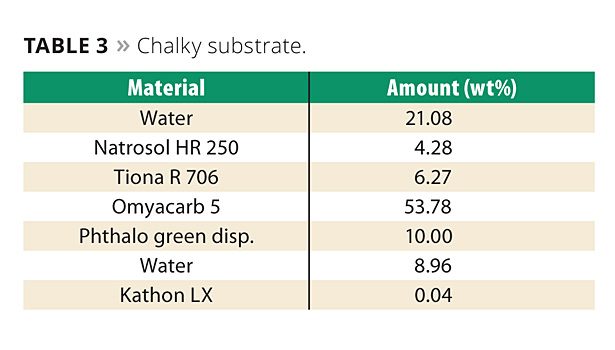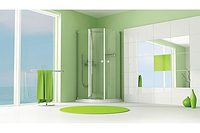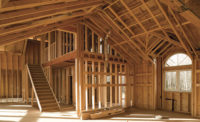Sealers are applied to concrete to protect the surface from water and salt damage. Acrylic sealers work by blocking the pores of the concrete from water adsorption. Unsealed surfaces can allow water to penetrate into the concrete, where it may freeze and cause cracking, or dissolve salts and carry them to the surface where they are deposited by water evaporation. This is called efflorescence and ruins the appearance of concrete because of scaly, white salt deposits that remain.
In addition to protecting concrete, sealers can also enhance the appearance of the surface by providing a “wet look”. The wet look is the darkening and drawing out of the color that occurs when the surface is wet. This may also include an enhancement of the surface gloss, although this is not a universal definition. Solventborne acrylic sealers do a good job of providing a wet look to concrete surfaces. Of course this comes with the price of higher VOC levels, typically 350 g/L or higher. Current waterborne wet-look sealers contain between 100 and 250 g/L of VOCs, while not delivering an appearance that matches a solventborne sealer. HydroPLIOLITE WL is a modified acrylic copolymer that gives the appearance and protection properties of a solventborne sealer and can be formulated into a sealer with a VOC level of only 50 g/L.
HydroPLIOLITE WL is made by our proprietary emulsified binder system (EBS) process. This process produces a waterborne polymer that acts more like a solventborne polymer.1 The viscosity of the polymer chains is much lower in the EBS droplets than it would be in a latex particle. This allows the polymer chains to better penetrate the concrete surface, resulting in superior properties.
Discussion
HydroPLIOLITE WL was formulated into a wet-look sealer; the formulation is shown in Table 1. This formulation had a VOC of 48 g/L at a solids content of 25% by weight. The two commercial sealers in this study were also at 25% solids content. The characteristics of the sealers evaluated are contained in Table 2. The commercial solventborne sealer had a VOC of 350 g/L, while the commercial waterborne sealer was at a VOC level of 100 g/L. The HydroPLIOLITE WL formulation contained only 50 g/L of VOC. Our goal in this project was to achieve the properties of a solventborne sealer while minimizing the amount of VOC necessary to achieve those properties.
To evaluate the appearance of a wet look, the same amount of each coating was applied by brush to a cement brick and allowed to dry overnight. For comparison, the lower quarter of the brick was not coated. As can be seen in Figure 1, the HydroPLIOLITE WL formulation looks very similar to the commercial solventborne sealer. Both add a darkness to the brick as well as a glossy surface. The commercial waterborne sealer does impart some darkening of the brick, but substantially less than the others, and very little gloss.
We have accomplished the first goal, namely making a waterborne sealer that gives a wet look similar to a solventborne, high-VOC control. Although appearance is important, it is not the only property of concern for a concrete sealer. It is important for concrete sealers to penetrate into the pores of the concrete for both adhesion to and protection of the surface. To measure the penetration of the coating into the concrete, the following test was developed. A chalky substrate was prepared according to the formulation given in Table 3. This chalky substrate was applied at 4 mils wet to a glass panel and allowed to dry for 24 h. The coating was then applied to the chalky substrate at 4 mils wet and allowed to dry. The penetration was determined by looking at the back of the glass panel and observing whether the coating reached through the chalky substrate to the glass panel.
Figure 2 shows the penetration of the sealer through the chalky substrate and its appearance on the glass below. In this photograph we are looking at the underside of the glass. The darker the color, the more the sealer has penetrated into the chalk. The commercial solventborne sealer shows significant penetration through the chalk. The HydroPLIOLITE WL sealer is darker than either of the commercial waterborne sealers. We believe this is due to the polymer chains of the HydroPLIOLITE WL being dissolved in the solvent rather than simply being softened, as in the case of traditionally coalesced latex.
This test can also be used to determine how well the coating can bind to chalky or weathered surfaces that may not have the integrity of freshly poured concrete. An “X” was cut into the coating through to the glass panel. A piece of Permacel #99 tape was placed over the cross hatch and then pulled off. The more coating/substrate that remains on the glass panel, the better the coating is at bonding the substrate to the panel.
The photographs in Figure 3 again are from the underside of the glass after the tape was removed. For both the commercial solventborne and the HydroPLIOLITE WL, very little of the chalk was removed from the glass substrate. For the commercial waterborne sealers, a significant portion of the chalk was removed along with the tape. The HydroPLIOLITE WL sealer performs more like the solventborne sealer in its ability to bind the surface together. This is important because not only does the HydroPLIOLITE WL sealer penetrate through the chalky substrate, it is also strong enough to bind the surface together.
One problem area with earlier versions of EBS technology was blush resistance and hardness.2 Surfactant was added to help form the emulsified polymer solution, and this can negatively impact the blush resistance of the coating.
The blush resistance was measured by coating a black glass panel at 3 mils wet and drying for 6 h under ambient conditions. The panel was then submerged in water for 16 h and the amount of blushing recorded. The rating scale was 0 for no blushing to 5 for total whitening.
Table 4 shows the improved blush resistance of the coating. The resistance was brought to an acceptable level through the choice of polymer composition and surfactant. By using a more hydrophilic polymer composition and more blush-resistant surfactants, the blush resistance was better than commercial waterborne sealer #2 and just slightly worse than commercial waterborne sealer #1. As was expected, the commercial solventborne sealer was very blush resistant.
Pencil hardness of the coatings was measured according to ASTM D3363. The coating was applied to an anodized aluminum Q-panel at 6 mils wet and allowed to dry for 4 days prior to testing. The HydroPLIOLITE WL sealer had hardness that was very similar to the two commercial waterborne sealers. The hardness was slightly less than the commercial solventborne sealer, however it must be remembered that the solventborne sealer contained 350 g/L of VOC compared to 50 g/L for the HydroPLIOLITE WL sealer.
We have had this sealer on a test patio in Akron, OH for 2 years. Figure 4 shows both the earlier prototype of the HydroPLIOLITE WL sealer and the commercial solventborne sealer. The patio was coated November 11, 2010. The pictures were taken on November 29, 2012. The coatings have been through two winters in Northeast Ohio and still look good.
Conclusions
By using EBS technology we have developed a waterborne wet-look sealer that has the appearance of a solventborne wet-look sealer with less than 50 g/L VOC. In addition to the appearance, the HydroPLIOLITE WL sealer also had similar penetration and binding to chalky substrates as the solventborne sealer did. The HydroPLIOLITE WL sealer had equivalent hardness and blush resistance compared to the best waterborne sealer. The HydroPLIOLITE WL sealer has been aged for two years, including two winters in Akron, Ohio, and still has a wet-look appearance without any signs of coating deterioration. n
References
1 Secher, M. New Acrylic Technology (EBS) For High-Performance Waterborne Masonry Primers, European Coatings Show, Nürnburg, 2007.
2 Flecksteiner, R. Use of Waterborne EBS Technology in Concrete Cure and Seals for Application to Previously Coated Concrete and to Achieve a Wet Look, Coatings for Concrete, Las Vegas, 2010.
For more information visit www.omnova.com.












Report Abusive Comment